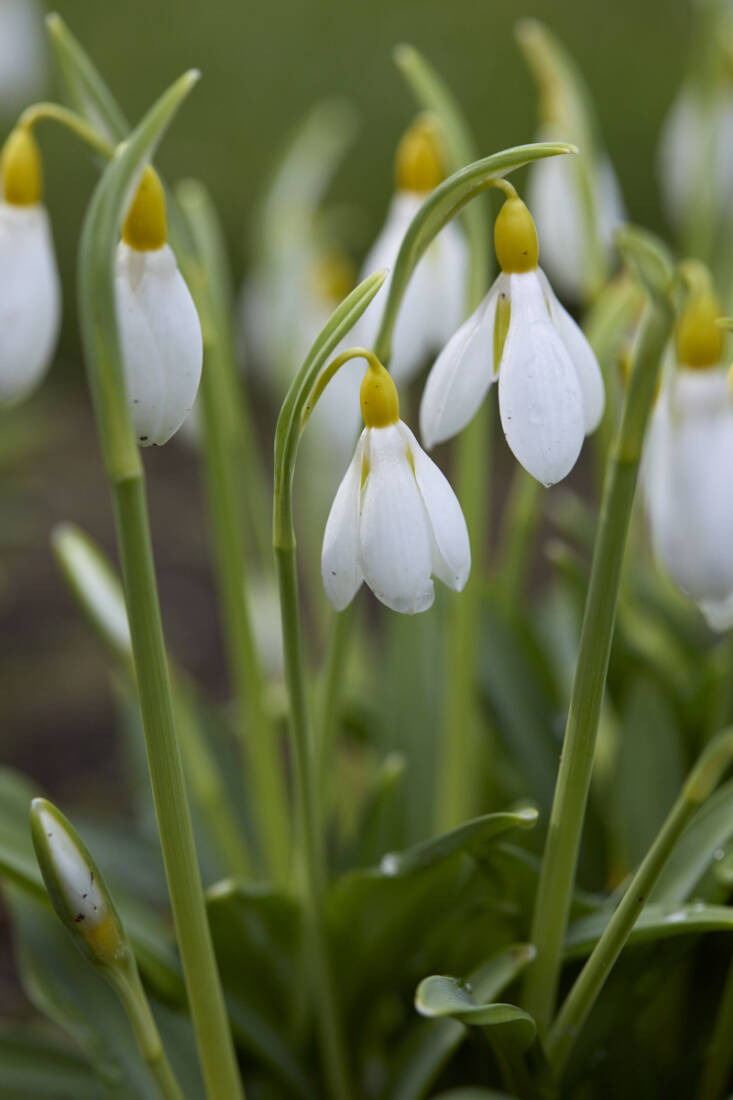The best way to start collecting snowdrops is, ideally, to receive a few paper bags of them from a friend. This is how the collection at Worcester College in Oxford began, after its current Head of Gardens and Grounds, Simon Bagnall, became friendly with legendary galanthophiles Dr Ronald Mackenzie and Ruby Baker. Before snowdrops made headlines because of the extraordinary cost of some of its cultivars (one obsessed fan bought a rare hybrid for £1,390), the flower represented something more personal for collectors: an excuse to get together in the last days of winter, and share. Gardeners are renowned for their generosity; Simon Bagnall rarely feels the need to buy snowdrops.
Modesty is another gardener’s attribute. Before showing us around last week, Simon protested that Worcester does not boast swathes of rare snowdrops, “but we do have the best collection in the city center.” Join us on a private tour:
Photography by Britt Willoughby Dyer.
What should you look for if you are starting a snowdrop collection?

When Simon posed this question 20 years ago to John Sales, former head of gardens for the National Trust, he said: “My best tip for starting a collection is to look for snowdrops that you can recognize from 12 yards.” Simon recommends Galanthus ‘Wasp’ (above); ‘Diggory’ with its rounded, puckered outer leaves (outers); and ‘Lady Beatrix Stanley’ with claw-like outers.
Which collectable snowdrops multiply well?

Galanthus ‘S. Arnott’ is justly popular as it spreads around easily, and is a taller, more showy alternative to the wild snowdrop, Galanthus nivalis. At Worcester College, ‘Magnet’ has made itself at home in a long, south-facing border. “‘Magnet’ loves us; we started with literally a few handfuls 10 years ago,” says Simon. “Every year we dig up the larger clumps, and divide them in three. We put one clump back where it was, and then the two other will go elsewhere in the border or around the garden.”
When is the best time to plant snowdrops?

The answer is no longer definitively “in the green,” the accepted practice for planting them just after they’ve flowered (snowdrops are considered by most people to establish better when they are not dried out). “The top boys now say ‘don’t move them in the green’,” says Simon. Experts prefer to move them in June or July, despite all of the claims on one’s attention at that time of year. No matter how carefully a clump is divided, goes this new thinking, plants are being yanked out of the ground when they are growing and they will suffer because of that.
That said, counters Simon, “they do move well in the green, and very successfully. You can see where they are; the border is generally cut down, and you can see where the gaps are at this time of the year.” He adds: “I think it’s important to say I’m not an expert.”
Do bulbs get in the way, in summer and autumn?

The ‘exotic border’ at Worcester College is dug and re-planted every year, as tender plants move in and out of their winter cover, but the snowdrops carry on regardless. “They just bomb about. We’re planting bananas in there and we’re not careful with the snowdrops; when they get dug up we chuck them back in.”
Which of these snowdrops do well with other plants?

Separated by a formal lawn on the main quad, medieval cottages built for Benedictine monks at the college face an 18th century terrace, designed by James Wyatt. Snowdrops are suited to both styles but it’s notable that on the modest, north-facing side, and competing with shrubs and cyclamen, there are several varieties that are just as happy as their south-facing counterparts, which generally have more space, and a lot more sun. These include: ‘Anglesey Abbey’, ‘Mighty Atom’ and, with a yellow ovary, ‘Spindlestone Surprise’.
What’s behind the names?

Giving a hint to the insouciant nature that characterized snowdrop collecting before people began to get overwrought by their potential value, a snowdrop collected by Ruby Baker was named, not after herself or the place where she found it but ‘Witchwood’. It was found in a wood, but she couldn’t remember which one.
How do you choose?

It’s purely subjective.
Is it important to know the type you have?

Relaxed snowdrop collectors appreciate unnamed snowdrops in their collection for being “good doers”—they are tall and strong; they spread easily, they don’t need labels.
Are you a galanthophile if you are not obsessed?

The term ‘galanthophile’ is not the most flattering, and there is much dignity to be had from being a collector, of many things (Simon for instance has added greatly to the tree collection at Worcester College during his 20-year tenure). “There is definitely a commercial side to snowdrops, but there is still a lovely community of people that just enjoy them for what they are,” he says. “They’re not chasing the latest must-have; they just get pleasure out of growing them.”

For more on snowdrops, see:
- Gardening 101: Snowdrops
- Garden Visit: Snowdrops Season at Cotswold Farm
- Garden Visit: Snowdrop Season at Painswick Rococo Garden












Have a Question or Comment About This Post?
Join the conversation (0)